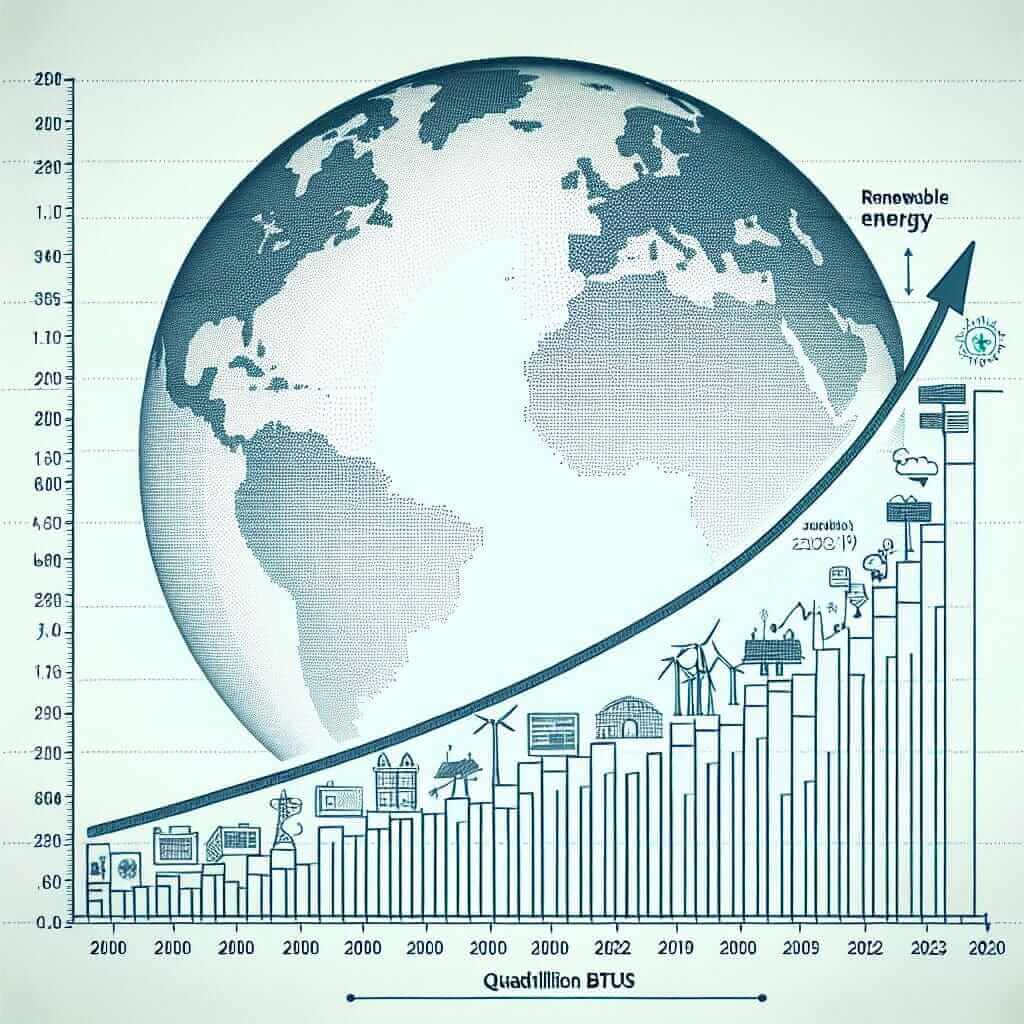Understanding trends in renewable energy consumption is a crucial topic, both for its relevance in current global issues and its frequent appearance in IELTS writing tasks. In this article, we’ll create a sample IELTS Writing Task 1 based on this topic, analyze the task, and provide a model answer. This will help you improve your writing skills and prepare effectively for the IELTS exam.
Sample Task
You should spend about 20 minutes on this task.
The line graph below shows the consumption of renewable energy in the world from 2000 to 2023.
Summarise the information by selecting and reporting the main features, and make comparisons where relevant.
Write at least 150 words.
Selected Task and Data
For this article, we will design a line graph for the task. Below is the description of the chart and its data:
Line Graph Description
The line graph shows the consumption of renewable energy (in quadrillion BTUs) globally, from 2000 to 2023. The data points are:
- 2000: 6
- 2005: 7.5
- 2010: 9
- 2015: 12
- 2020: 15
- 2023: 18
The graph illustrates an overall upward trend in the consumption of renewable energy over the 23-year period.

Analysis of the Task
- Beginning (Introduction): Paraphrase the task statement.
- Overview: Provide a brief summary of the main trends.
- Body Paragraphs: Describe specific data points, comparisons, and notable trends or changes.
Sample Answer and Analysis
Model Answer
The line graph illustrates the consumption of renewable energy worldwide from 2000 to 2023, measured in quadrillion BTUs.
Overall, there was a significant increase in the use of renewable energy over this period. The consumption started at 6 quadrillion BTUs in 2000 and rose steadily to reach 18 quadrillion BTUs by 2023.
In more detail, from 2000 to 2005, the use of renewable energy grew gradually from 6 to 7.5 quadrillion BTUs. This rate of increase continued for the following five years, and by 2010, consumption had reached 9 quadrillion BTUs. The rate of growth accelerated after 2010, with consumption rising more sharply from 9 quadrillion BTUs in 2010 to 12 quadrillion BTUs in 2015.
The trend continued with even greater momentum between 2015 and 2020, as renewable energy consumption surged from 12 to 15 quadrillion BTUs. Finally, from 2020 to 2023, consumption climbed further to 18 quadrillion BTUs, marking the steepest increase observed during the entire period.
In conclusion, the global consumption of renewable energy has seen a continuous upward trajectory from 2000 to 2023, with the most noticeable increases occurring after 2010.
(Word count: 186)
Key Notes and Tips for Writing
- Paraphrasing: When introducing the topic, always paraphrase the task description to show your language proficiency.
- Overview: Provide a clear summary of the major trend without specific data points in the overview paragraph.
- Details: Include specific data points in body paragraphs to offer detailed comparisons and describe notable changes.
- Linking Devices: Use linking phrases like “in more detail,” “this rate of increase,” “accelerated,” and “surged” to show the progression and changes effectively.
Vocabulary and Grammar
Vocabulary
-
Consumption (n.) [kənˈsʌmp.ʃən]: The act of using energy, food, or materials.
-
Quadrillion (adj.) [kwɒˈdrɪl.jən] BTUs (n.) [ˈbɪɔːrt·ju]: A unit of energy measurement.
-
Upward Trend (n.) [ʌpˈwɝːd trɛnd]: A consistent increase in a particular factor.
-
Steadily (adv.) [ˈstɛd·əl·i]: In a regular and even manner.
-
Accelerated (v.) [əkˈsɛl·əˌreɪ·tɪd]: To move or develop faster.
Grammar
-
Past Simple Tense: Use past simple tense to describe specific events (e.g., “The consumption started at 6 quadrillion BTUs in 2000”).
-
Present Perfect Tense: Use present perfect in the overview to describe overall trends (e.g., “There has been a significant increase”).
Conclusion
To excel in writing tasks related to trends, such as renewable energy consumption, it is vital to describe the visual data accurately, provide a clear overview, and include specific data points with appropriate vocabulary and grammatical structures. By practicing regularly and using these tips, you can aim for a high band score in IELTS Writing Task 1.